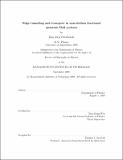Edge tunneling and transport in non-abelian fractional quantum Hall systems
Author(s)
Overbosch, Bas Jorn
DownloadFull printable version (1.737Mb)
Other Contributors
Massachusetts Institute of Technology. Dept. of Physics.
Advisor
Xiao-Gang Wen.
Terms of use
Metadata
Show full item recordAbstract
Several aspects of tunneling at the edge of a fractional quantum Hall (FQH) state are studied. Most examples are given for the non- abelian filling fraction ? = 5 2 Moore-Read Pfaffian state. For tunneling between opposite edges of an abelian fractional quantum Hall state at a quantum point contact, the perturbative calculation of tunneling current, conductance, and current noise, as a function of finite bias and temperature, is reviewed. We extend this formalism to include non-abelian FQH states as well. The crucial ingredient is conformal block decomposition. We argue the validity of perturbation theory to arbitrary order. A double point contact interferometer is considered for the v = 5/2 FQH state, for which a vanishing interference pattern in the tunneling current was predicted when a non-abelian quasiparticle is trapped inside the interferometer. We confirm this result in a dynamical edge calculation. We show how interference can be restored through a higher order tunneling process, which exchanges a charge neutral quasiparticle between the central island and one of the edges. On the edge of the v = 5/2 Pfaffian and anti-Pfaffian FQH states interactions can cause a transition to another phase. The relevant operator that condenses in this process consists of tunneling of electrons between the different edge branches. Under the phase transition a pair of counter propagating Majorana modes acquires a gap. The transition is an edge only phase transition, as the bulk state is unchanged. Such a transition can change the observed quasiparticle charge and exponent as measured in transport. The Majora-gapping transition shows similarities to a transition due to edge reconstruction. A setup is proposed that can probe slow edge velocities that may be present in certain abelian and non-abelian FQH state. At a long tunneling contact the coherent interference of tunneling quasiparticles causes a resonance in the tunneling current. From a high-precision observation of such a resonance not only the slow edge velocity can be determined, but also quasiparticle charge as well as neutral and charged tunneling exponents. Temperature is found to set an effective decoherence length scale.
Description
Thesis (Ph. D.)--Massachusetts Institute of Technology, Dept. of Physics, 2008. This electronic version was submitted by the student author. The certified thesis is available in the Institute Archives and Special Collections. Includes bibliographical references (p. 115-121).
Date issued
2008Department
Massachusetts Institute of Technology. Department of PhysicsPublisher
Massachusetts Institute of Technology
Keywords
Physics.